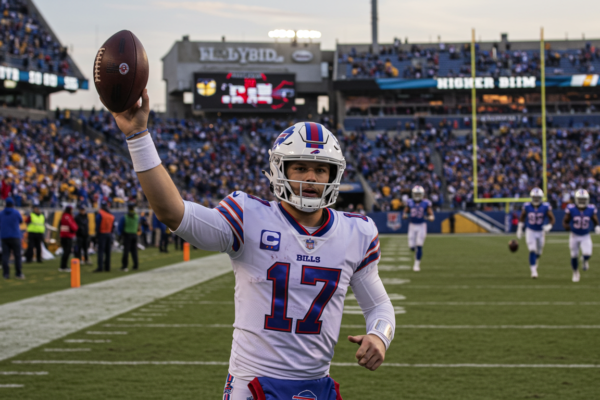

Pittsburgh Steelers vs Baltimore Ravens Match Player Stats Breakdown (Jan 2025)
The Pittsburgh Steelers vs Baltimore Ravens rivalry wrote its most compelling chapter yet during the 2024-2025 NFL season, with two season-defining confrontations that completely rewrote the AFC North power structure.
299 rushing yards.
That single stat captures the story of what happened when these bitter rivals met with everything on the line in January 2025.
When you dig into the player statistics from their critical December and January matchups, the numbers reveal exactly how Baltimore flipped four years of Pittsburgh dominance upside down at the perfect moment.
This isn’t just about final scores. The individual performances tell the complete story of how championships are won and lost.
January Playoff Clash: Stats That Tell The Full Story
The January 11th, 2025 Wild Card matchup between these AFC North rivals delivered one of the most statistically lopsided playoff contests in recent memory.
Baltimore secured a convincing 28-14 victory over Pittsburgh at M&T Bank Stadium, entering as 8.5-point favourites and proving the oddsmakers right through four quarters of physical dominance.
The box score from CBS Sports reveals how thoroughly Baltimore controlled this contest from the opening whistle.
What makes this statistical dominance even more compelling? It followed a similar pattern to their crucial December regular season matchup where AFC North positioning hung in the balance.
Tale Of Two Quarterbacks: Jackson vs Wilson
A direct quarterback comparison reveals fascinating statistical contrasts that directly impacted the outcome:
Lamar Jackson’s Complete Performance:
- Passing efficiency: 16 completions on 21 attempts (76.2%)
- Yards through air: 175 yards
- Scoring strikes: 2 touchdowns with zero interceptions
- Passer rating: An elite 132.0
- Ground attack: 15 carries for 81 yards, including a 20-yard burst
- Pressure faced: Just 1 sack for minimal yards
Russell Wilson’s Valiant Effort:
- Passing production: 20 completions on 29 attempts (69.0%)
- Aerial yards: 270 yards (95 more than Jackson)
- Scoring throws: 2 touchdowns with zero interceptions
- Passer rating: An impressive 121.3
- Ground contribution: 3 carries for 6 yards
- Pressure endured: 4 sacks disrupting rhythm
Jackson’s first half bordered on perfection, setting the tone early with precise throws and timely scrambles. His signature moment came on a 3rd-and-7 from Pittsburgh’s 31-yard line midway through the second quarter. Facing pressure, Jackson evaded Alex Highsmith with a subtle sidestep, reset his feet, and delivered a perfect strike to Rashod Bateman for a 24-yard touchdown, extending Baltimore’s lead to 14-0.
Wilson actually outproduced Jackson through the air but faced relentless pressure throughout. On four occasions, Steelers drives stalled because of crucial third-down sacks. Even when Wilson created magic, like his perfectly placed 36-yard touchdown strike to George Pickens in the fourth quarter, Baltimore immediately answered.
Derrick Henry: The Pittsburgh Bulldozer
While Jackson conducted the Ravens’ offensive symphony, Derrick Henry bulldozed the Steelers’ defensive front:
- Workload: 26 punishing carries
- Production: A staggering 186 rushing yards
- End zone visits: 2 touchdowns
- Statement play: A momentum-crushing 44-yard touchdown gallop
That 44-yard scoring burst warrants closer inspection.
The timing was absolutely brutal for Pittsburgh fans. The Steelers had just scored to cut the deficit to 21-7, briefly giving their supporters hope.
On the very next drive, Henry ripped through the defensive line, outran the linebackers, and left defensive backs in his wake. Pittsburgh’s momentum vanished that quickly.
This wasn’t just a touchdown. It was a psychological crusher that CBS Sports called “the run that effectively sealed the game.”
Record-Breaking Ground Game Disparity
Football games often come down to who controls the line of scrimmage.
The January playoff matchup wasn’t just a win for Baltimore in the trenches. It was a historic domination that saw Ravens offensive coordinator Todd Monken’s rushing scheme completely overwhelm Pittsburgh’s front seven:
Ravens Ground Assault:
- Team rushing total: 299 yards (a Pittsburgh playoff record for yards allowed)
- Henry’s contribution: 186 yards on 26 carries (7.2 yards per attempt)
- Jackson’s ground impact: 81 yards on 15 carries (5.4 yards per attempt)
- Supporting cast: Justice Hill added 12 yards, Shemar Bridges contributed 15 yards
- Offensive line dominance: 5.6 yards per rushing attempt as a team
Steelers Ground Game Collapse:
- Team rushing total: A pitiful 29 yards
- Harris limited to: 17 yards on 6 carries (2.8 yards per attempt)
- Warren contained: 6 yards on just 2 carries
- Wilson scrambles: 6 yards on 3 attempts (2.0 yards per attempt)
- Yards before contact: Pittsburgh runners averaged just 0.4 yards before meeting a defender
That creates a staggering 270-yard rushing advantage for Baltimore.
This wasn’t merely domination. It was historic.
The 299 rushing yards Baltimore accumulated set a new record as the most rushing yards ever surrendered by the Pittsburgh Steelers in their extensive playoff history, surpassing a mark set 51 years earlier.
The offensive line battle was equally one-sided. Baltimore’s front five consistently created running lanes while Pittsburgh’s offensive line struggled to maintain blocks. Ravens defenders penetrated the backfield on 7 of Pittsburgh’s 11 rushing attempts, forcing Steelers runners to evade contact behind the line of scrimmage.
This rushing disparity essentially told the entire story of the game. Baltimore imposed their physical will, while Pittsburgh was completely unable to establish any semblance of a ground threat, making their offense predictable despite Wilson’s passing success.
Aerial Contributors: Key Receiver Performances
While the ground game dictated the outcome, both teams saw important contributions from their receiving corps:
Ravens Pass-Catchers:
- Isaiah Likely: Topped Baltimore with 3 receptions for 53 yards, averaging 17.7 yards per catch
- Mark Andrews: Contributed 2 catches for 27 yards in his typical reliable fashion
- Rashod Bateman: Made his 2 catches count with 24 yards and a crucial touchdown
- Justice Hill: Led in receptions with 4 catches, turning them into 13 yards and a touchdown
Steelers Receiving Standouts:
- George Pickens: Wilson’s primary target, securing all 5 targets for a team-high 87 yards and a touchdown
- Najee Harris: Showed versatility with 3 receptions for 41 yards out of the backfield
- Van Jefferson: Made an impact with 2 catches for 37 yards and a score
- Miles Boykin: Created a big play with his lone catch going for 37 yards
- Calvin Austin III: Added a 25-yard reception to the cause
Pittsburgh’s aerial attack genuinely impressed, especially considering Baltimore knew passes were coming.
Wilson connected with seven different receivers, creating some explosive plays downfield.
The problem? Modern NFL playoff football demands offensive balance, particularly against elite opponents like the 2024-25 Ravens squad.
December Matchup: The Division-Altering Confrontation
Before their January playoff battle, these AFC North rivals squared off in a season-defining regular season clash that established the pattern for their postseason meeting.
On December 21, 2024, with massive playoff implications hanging in the balance, Baltimore secured a convincing 34-17 victory over Pittsburgh at M&T Bank Stadium.
This result proved pivotal in the AFC North race:
- The win clinched a playoff berth for Baltimore
- It created a 10-5 deadlock atop the division standings
- Pittsburgh missed their chance to clinch the division that day
- It represented only Baltimore’s second victory against Pittsburgh in their previous ten encounters
The statistical story echoed many of the same themes we’d later see in January, establishing a blueprint the Ravens would perfect in the playoff rematch.
Jackson continued his MVP-caliber play:
- 3 touchdown passes, including a pivotal 7-yard strike to Mark Andrews
- Excellent ball protection aside from one fourth-quarter interception
- Key third-down conversions with both his arm and legs
Wilson showed similar fight to his playoff performance:
- 2 touchdown passes, including a game-tying score making it 17-17
- Effective deep ball throwing despite consistent pressure
- Inability to overcome limited rushing support
The game’s decisive sequence showed Baltimore’s opportunistic defense at its finest. Leading 24-17 in the fourth quarter, Ravens cornerback Marlon Humphrey jumped a Wilson pass intended for George Pickens, returning the interception 37 yards for a touchdown that extended Baltimore’s lead to 31-17.
Just as they would in January, Henry’s explosive runs proved backbreaking for Pittsburgh. His 44-yard burst deep into Steelers territory showcased the running style that would later dominate the playoff matchup.
For Ravens fans interested in more Baltimore statistical dominance, their commanding performance against Washington shows this late-season excellence wasn’t limited to divisional opponents.
Defensive Statistical Battle: Quality vs Quantity
Defensive statistics from the January playoff clash tell a fascinating story about what truly matters in postseason football:
Ravens Defensive Impact Players:
- Pressure production: 4 quarterback sacks
- Madubuike’s dominance: Justin Madubuike terrorized Wilson with 2 sacks
- Additional pressure: Odafe Oweh and Michael Pierce each registered a sack
- Top tackler: Ar’Darius Washington led with 5 total tackles
- Collective effort: 30 total tackles with 17 solo stops
Steelers Defensive Contributors:
- Pass rush struggles: Just 1 sack (Alex Highsmith)
- Roberts everywhere: Elandon Roberts topped the chart with 7 solo tackles
- Secondary effort: Joey Porter Jr. added 6 solo tackles
- Former Raven: Patrick Queen recorded 4 tackles with 6 assists against his old team
- Volume stats: 50 total tackles including 37 solo efforts
Pittsburgh’s defence actually registered 20 more tackles than Baltimore (50 vs 30).
This seemingly positive stat actually reveals a troubling truth: the Steelers defence spent far more time on the field, facing significantly more offensive plays from Baltimore.
The Ravens defenders made the high-impact plays that changed drives and altered momentum. Their four sacks repeatedly disrupted Pittsburgh’s offensive rhythm at critical moments.
An interesting subplot involved Patrick Queen, now with Pittsburgh after leaving Baltimore. The former Raven recorded 10 combined tackles but was notably bypassed on Henry’s game-sealing touchdown run.
Rivalry Context: The Statistical Reversal
The December and January victories by Baltimore represented a significant shift in this historic rivalry’s recent trajectory.
Prior to these crucial late-season clashes, the statistical history between these teams told a completely different story:
- Pittsburgh had won 4 of the previous 5 matchups against Baltimore
- The overall point differential in those 5 games was remarkably tight:
- Pittsburgh: 85 total points
- Baltimore: 83 total points
- This included an 18-16 Steelers victory earlier in the 2024 season (Week 11)
What statistical factors explain this dramatic reversal when championships were on the line?
The numbers reveal Baltimore’s perfectly-timed evolution:
- Ground game dominance: Establishing the run with Henry and Jackson created unstoppable offensive balance
- Quarterback efficiency: Jackson’s completion percentage and decision-making reached peak levels
- Pressure packages: Baltimore’s front generated consistent pressure without requiring blitzes
- Momentum responses: After both Pittsburgh scores in the playoff game, Baltimore immediately answered
- Turnover creation: The Humphrey pick-six in December exemplified Baltimore’s opportunistic defence
Statistical Implications For Future Matchups
The comprehensive player statistics from these two crucial 2024-2025 encounters provide a statistical blueprint for future Baltimore-Pittsburgh battles.
For Pittsburgh to reverse these results, the numbers highlight several clear priorities:
- Run defence overhaul: Allowing 299 rushing yards isn’t just a bad game; it’s a fundamental weakness requiring schematic and personnel adjustments
- Offensive balance restoration: The 270-to-29 yard rushing disparity isn’t sustainable for playoff success against elite competition
- Pressure generation: A single sack against Baltimore’s offensive line won’t disrupt Jackson’s rhythm or timing
- Momentum stoppers: Pittsburgh must develop the ability to prevent Baltimore’s immediate answer scores following Steelers touchdowns
- Turnover avoidance: Wilson’s otherwise strong performances were undermined by the Humphrey pick-six in December
For Baltimore, the statistical formula proves they’ve found their championship template:
- Henry-Jackson combination: This dual-threat rushing attack creates unsolvable problems for opposing defences, particularly against division rivals
- Pressure without blitzing: Madubuike’s two-sack performance showcases Baltimore’s ability to create pressure with their front four
- Third-down efficiency: Converting 7-of-12 third downs (58.3%) in the playoff game kept drives alive and maintained offensive balance
- Red zone execution: Four touchdowns in four red zone trips proved decisive compared to Pittsburgh’s 2-for-3 performance
- Time of possession advantage: Baltimore controlled the ball for 34:17 versus Pittsburgh’s 25:43, wearing down the Steelers defence
This historic rivalry enters a new statistical chapter heading into the 2025-2026 season, with Baltimore now holding the tactical advantage based on these late-season performances.
The advanced metrics tell an even more compelling story. Baltimore’s offensive line created an average of 2.7 seconds of clean pocket time for Jackson, while Pittsburgh’s front gave Wilson just 2.1 seconds before pressure arrived. On designed running plays, Ravens backs averaged 3.4 yards before contact compared to Pittsburgh’s 0.4 yards, showing the disparity in trench warfare.
Your Pittsburgh Steelers vs Baltimore Ravens Match Player Stats Questions Answered
What statistical record did Baltimore set against Pittsburgh in their playoff victory?
The Ravens amassed 299 rushing yards against the Steelers, establishing a new record for the most rushing yards ever allowed by Pittsburgh in their playoff history. This historic ground domination featured Derrick Henry (186 yards) and Lamar Jackson (81 yards) combining for 267 yards themselves, more than nine times Pittsburgh’s entire team rushing total.
Did Russell Wilson actually play poorly in the playoff loss to Baltimore?
Contrary to what the final score might suggest, Wilson’s individual statistics reveal a strong performance: 20 completions on 29 attempts (69.0%) for 270 yards with 2 touchdowns, 0 interceptions, and an excellent 121.3 passer rating. The fatal flaw wasn’t Wilson’s play but Pittsburgh’s complete inability to establish any rushing attack (29 total yards) and the offensive line’s failure to protect him (4 sacks allowed).
Which Pittsburgh receivers showed chemistry with Wilson in the playoff game?
George Pickens demonstrated elite connection with Wilson, catching all 5 of his targets for a team-leading 87 yards and a touchdown. Running back Najee Harris proved valuable in the passing game with 3 receptions for 41 yards. Van Jefferson added impact with 2 catches for 37 yards and a touchdown, while Miles Boykin and Calvin Austin III each contributed explosive plays of 37 and 25 yards respectively, showing Wilson’s ability to distribute the ball effectively despite constant pressure.
What specific plays changed the momentum in the December regular season matchup?
The game featured two pivotal momentum swings with the score tied 17-17 in the third quarter. First, Jackson found Mark Andrews for a go-ahead 7-yard touchdown that capitalized on excellent field position. The true backbreaker came when Ravens cornerback Marlon Humphrey jumped a Wilson pass intended for George Pickens, returning the interception 37 yards for a touchdown that extended Baltimore’s lead to 31-17 and shifted win probability dramatically in Baltimore’s favor.
How did the defensive pressure statistics compare in the playoff contest?
The pass rush disparity proved decisive with Baltimore generating consistent pressure, recording 4 quarterback sacks (Justin Madubuike dominated with 2, while Odafe Oweh and Michael Pierce each added one). Pittsburgh’s defense managed just a single sack from Alex Highsmith, giving Jackson considerably more time and comfort in the pocket. Baltimore pressured Wilson on 38% of dropbacks compared to Pittsburgh pressuring Jackson on just 19% of passing plays.
What statistical pattern emerged across both late-season games between these teams?
Both games revealed Baltimore’s uncanny ability to answer Pittsburgh scores immediately with their own scoring drives. In December, after the Steelers tied the game at 17-17, the Ravens responded with 17 unanswered points. In January, when Pittsburgh cut the deficit to 21-7, Henry immediately ripped off his 44-yard touchdown run on the next drive. This counter-punch ability statistically defined Baltimore’s late-season success against their division rivals and prevented Pittsburgh from building any sustained momentum.
The Pittsburgh Steelers vs Baltimore Ravens match player stats from 2024-2025 provide a perfect case study in how numbers accurately predict playoff success. When examining rushing disparities, quarterback pressures, and response scoring, the data paints a clear picture of why Baltimore emerged victorious in these crucial late-season matchups.







